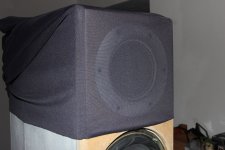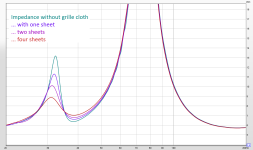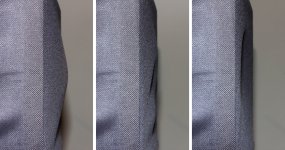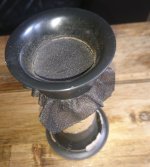I have a ported sub which lives outside. The rear-facing port would seem to be an open invitation for mice, wasps, or small birds to set up home inside the cabinet. I plan to cover the inside aperture of the vent with speaker grill cloth but it stands to reason this will have some affect on airflow.
Thoughts?
Thoughts?
I don't believe such a cloth exists. Any barrier must affect airflow to some degree.Select cloth which has no effect. Simple as that.
If you manage to keep the cloth with some distance to the port opening (maybe 5-10 cm/2-4") the air speed and movement is very much reduced.
The question is - will animals still enter the port?
Maybe a metal grille at the outside end of the port? Still with some distance to minimize air movement/air speed.
Edit: if there is a big flare at the inside end of the port the airspeed and movement will be small and covering this end of the port will have less influence, except for lowering the tuning.
You could just try it out ...
The question is - will animals still enter the port?
Maybe a metal grille at the outside end of the port? Still with some distance to minimize air movement/air speed.
Edit: if there is a big flare at the inside end of the port the airspeed and movement will be small and covering this end of the port will have less influence, except for lowering the tuning.
You could just try it out ...
Grille cloth won't hold up to mice, etc.
Window screen mesh would be a better choice. Chicken wire also, though that will allow smaller insects in. Both with have a negligible impact on the vent's response.
Window screen mesh would be a better choice. Chicken wire also, though that will allow smaller insects in. Both with have a negligible impact on the vent's response.
This will definitely lower the tuning frequency.similar to this.
Through reduction of port surface and/or added weigth.
At higher levels (big air movement in the port) there might also be some non-linear effect, leading to chuffing and distorsion.
Ports are not supposed to flow air, the slug of air in the port should wiggle back and forth.I plan to cover the inside aperture of the vent with speaker grill cloth but it stands to reason this will have some affect on airflow.
Most speaker ports are covered with grill cloth.
Grill cloth won't have any more affect on port tuning or output on the inside of the port than outside.
That material looks quite breathable, based on what I've measured, it won't lower the tuning frequency at all.This will definitely lower the tuning frequency.
Art
It will move with the air and thus add weight to it.it won't lower the tuning frequency at all.
But I guess the difference will not cause much damage.
During my port investigations I realized how much the air in the port is moving, once you turn up the volume. Generally, ports of commercial speakers tend to be rather small. So air movement and any disturbance will affect its function.
Have a look at the port noise spectrum if you only glue some sand on the port wall surface: https://www.diyaudio.com/community/...rbers-and-port-geometries.388264/post-7518740
I'll add that the Q of the resonator will be lower with the cloth.But I guess the difference will not cause much damage
To confirm my assuptions I'll measure it and report back.
Some sort of metal mesh will do. Or screw a fan grille on, backed with a finer material. https://grabcad.com/library/fan-grill-80-mm-1
Or extend the port a bit with something like this: https://www.homedepot.com/p/PLUMBFL...densation-Drain-TVENT3/305851781?emt_ppq_vfpd
Or extend the port a bit with something like this: https://www.homedepot.com/p/PLUMBFL...densation-Drain-TVENT3/305851781?emt_ppq_vfpd
I've just realised, I wouldn't bother buying a metal sieve; when I started making speakers, I use car speakers that came with metal grills with a plastic surround, I still have a pile of unused black grills, so I'd just use one of them, you can buy the grills separately quite cheaply.
I'll bet the Q, Fb and frequency response changes if acoustically transparent grill cloth is used will be difficult to see in a measurement, much less hear. I'd also bet the changes will be less than flipping a cabinet with it's port near the floor upside down.I'll add that the Q of the resonator will be lower with the cloth.
Looking forward to the measurements, I never bothered to save mine.To confirm my assuptions I'll measure it and report back.
Past dates have left pantyhose - I'm sure they'll do fine.I've just realised, I wouldn't bother buying a metal sieve; when I started making speakers, I use car speakers that came with metal grills with a plastic surround, I still have a pile of unused black grills, so I'd just use one of them, you can buy the grills separately quite cheaply.
You could be on to something. Just spit-balling . . . We could have a bona-fide 'frying tonight' situation going on. How many volts go to a 200w subwoofer? . . . What DC voltage would kill a mouse? Do dead mice provide good damping? Would airflow through the port dissipate the smell?These did fine:
Here are my investigation results:To confirm my assuptions I'll measure it and report back.
I used my test subwoofer with "port optimizer" created port geometry, see here.
I have some dedicated speaker grille cloth at hand, bought at toutlehautparleur.
It is a thin and light cloth, slighly transparent:

photo taken with flash, thus slightly more transparent than normal.
This is the impedance measurement taken at 0.5 V rms and with 8 Ohm series resistance.
without cloth, with one sheet and (for confirmation of its effect) two and four sheets of speaker grille cloth:

cloth mainly influences the resonator Q, as I mentioned:
I'll add that the Q of the resonator will be lower with the cloth.
The resonance frequency does indeed only change very slightly:
I'll bet [...] Fb [...] changes if acoustically transparent grill cloth is used will be difficult to see in a measurement
When driving the speaker at Fb and slightly higher levels (4 V in my case) the cloth is moving quite a lot and starts to slap against the baffle.
This happened because I simply wrapped the cloth around the speaker.
Anyhow, the cloth moves A LOT with the air of the port.
Photos of moving cloth at 4 V rms, again taken with flash:

The movement could be reduced by stretching the cloth, but that would probably affect air particle movement even stronger.
The cloth did not create any audible hiss/noise, as I would have expected. Not at lower levels before the slapping noise was predominant, at least.
Hornresp simulation (with a constant port diameter equal port opening of my speaker and corresponding increase of length for correct tuning) resulted in a strouhal number of ~4,3.
that translates into a particle displacement distance of about 4.6 cm (p-p) at 37 Hz and 4 V rms input. Cloth seemed to move just as much.
My conclusion: the cloth does indeed affect the air motion of bass reflex ports. For low SPL and low air displacement the cloth can simply follow the air movement and the effect is probably neglible and will just slightly reduce the efficiency of the port.
At higher levels the air flow is affected and I would generally not advise to use grille cloth near the opening of a port - let alone inside the port!
Last edited:
- Home
- Loudspeakers
- Subwoofers
- Does Speaker Grill Cloth affect port behaviour?
